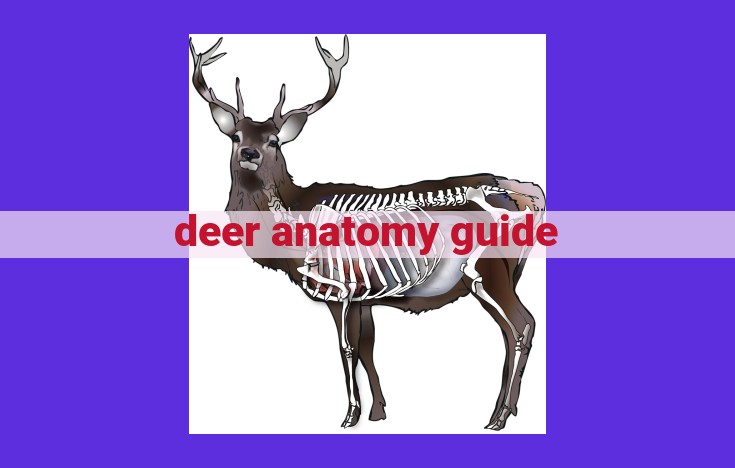A comprehensive guide to deer anatomy, covering the skeletal structure, connective tissue, musculature, regulatory systems, and essential systems. It explores the axial and appendicular skeletons, discusses bones, joints, cartilage, and muscles, and explains nervous system function, hormone regulation, circulation, respiration, digestion, urinary processes, and reproduction, providing insights into the inner workings of these graceful animals.
Understanding the Deer’s Skeletal Structure
- Explore the axial skeleton, including the skull, vertebrae, ribs, and sternum.
- Examine the appendicular skeleton, encompassing the limbs and girdles that facilitate mobility.
Understanding the Deer’s Skeletal Structure: A Journey of Support and Mobility
The deer, a graceful creature of the forest, possesses a remarkable skeletal structure that enables its agility and survival. Its skeleton, composed of bones, cartilage, joints, ligaments, and tendons, provides support, protection, and facilitates movement.
Axial Skeleton: The Core of Strength
The axial skeleton forms the central axis of the body and includes the skull, vertebrae, ribs, and sternum. The skull houses the brain and sensory organs, providing protection and support. The flexible vertebrae allow for movement and protect the delicate spinal cord. The ribs and sternum enclose the chest cavity, safeguarding vital organs like the heart and lungs.
Appendicular Skeleton: Mobility in Motion
The appendicular skeleton encompasses the limbs (forelimbs and hindlimbs) and girdles (shoulder girdle and pelvic girdle). The sturdy shoulder girdle connects the forelimbs to the axial skeleton, while the pelvic girdle supports the hindlimbs. The limbs consist of long bones (humerus, radius, ulna, femur, tibia, and fibula) that provide leverage and enable movement.
Joints: The Hinges of the Body
Joints are the points where bones meet, allowing for a wide range of motion. Some joints, such as the ball-and-socket joint in the hip, provide a wide range of movement, while others, like the hinge joint in the knee, allow for one-way movement. Ligaments and tendons connect bones to each other and to muscles, providing stability and facilitating movement.
Connective Tissue: The Support System of Deer
In the intricate tapestry of a deer’s anatomy, connective tissue plays a vital role in providing the framework that sustains their captivating movements and protects their delicate forms. Bones, the rigid and mineralized pillars of the skeletal structure, stand as the primary source of support. They shield the brain within the protective confines of the skull, encase the spinal cord along the vertebrae, and form the sturdy framework of the limbs.
Beyond the skeletal system, connective tissue manifests in diverse forms to orchestrate a symphony of functions. Cartilage, a flexible and resilient substance, imparts cushioning to the joints, preventing bone-on-bone contact and facilitating smooth, fluid movement. It lines the delicate surfaces of the respiratory tract and trachea, ensuring the unimpeded passage of air into and out of the lungs.
Joints, the dynamic meeting points between bones, are pivotal to the deer’s agility. Ligaments, strong bands of connective tissue, envelop joints, providing stability and preventing excessive movement that could result in injury. Tendons, the sturdy cords that connect muscles to bones, transmit the force generated by muscular contractions, enabling the deer’s graceful leaps and swift sprints.
Through the interplay of these interconnected components, connective tissue not only supports and protects the deer’s body but also empowers its effortless mobility. It is a living, breathing network that allows them to navigate their environment with the grace and agility that has become synonymous with these majestic creatures.
The Musculature: Powering Deer Movement
In the realm of deer anatomy, muscles reign supreme as the driving force behind their graceful movements. These remarkable contractile tissues, embodying the very essence of motion, orchestrate the deer’s every stride, leap, and bound.
Every fiber within the deer’s muscular system is a testament to the extraordinary adaptations that have shaped this elusive creature. From their sleek and agile bodies to their impressive sprint capabilities, deer rely heavily on their intricate musculature to navigate their diverse habitats.
The deer’s musculature consists of three primary muscle types: skeletal muscle, smooth muscle, and cardiac muscle. Skeletal muscle, the most prevalent type, is responsible for voluntary movement and is attached to bones by tendons. These muscles allow deer to control their limbs, manipulate their environment, and execute complex behaviors.
Smooth muscle, on the other hand, functions involuntarily and controls the internal organs, such as the stomach, intestines, and blood vessels. It regulates essential physiological processes, including digestion and circulation.
Finally, cardiac muscle is the specialized tissue that forms the heart. This involuntary muscle contracts rhythmically, pumping blood throughout the deer’s body and ensuring a continuous supply of oxygen and nutrients to all tissues.
The coordination of these muscle types is essential for the deer’s survival. Together, they enable deer to flee predators, navigate treacherous terrain, and fulfill their ecological roles within their environment. The intricate interplay between the deer’s musculature, skeletal structure, and regulatory systems is a testament to the marvels of nature’s design.
Regulatory Systems: Controlling Bodily Functions
In the intricate tapestry of a deer’s anatomy, two regulatory systems play a pivotal role in orchestrating the symphony of life: the nervous system and the endocrine system. These systems work in concert to control bodily functions, ensuring the deer’s ability to adapt, respond, and thrive in its environment.
The Nervous System: Sensory Perception, Motor Control, and Communication
Imagine a deer grazing peacefully in a meadow, its keen sensory organs detecting the slightest rustle of leaves. This is the realm of the nervous system, the master communicator that receives these sensory inputs and processes them into meaningful information. The deer’s brain, the central command center, interprets these signals and issues commands to the body, triggering a quick response.
The nervous system is also crucial for motor control, coordinating the deer’s graceful movements. As it bounds effortlessly across the forest floor, the nervous system sends precise signals to the muscles, controlling their contraction and relaxation. This symphony of coordination allows the deer to navigate its surroundings with agility and ease.
The Endocrine System: Regulating Bodily Functions through Hormones
While the nervous system operates on the rapid timescale of electrical impulses, the endocrine system, on the other hand, employs a different approach. It utilizes hormones, chemical messengers that travel through the bloodstream to specific target cells.
Hormones are responsible for regulating a vast array of bodily functions, including growth, metabolism, and reproduction. For example, the hormone insulin, produced by the pancreas, plays a crucial role in regulating blood sugar levels. By secreting insulin, the pancreas ensures that the deer’s energy levels remain stable and its bodily functions operate smoothly.
Interplay of the Regulatory Systems
The nervous system and endocrine system, though distinct in their mechanisms, work hand in hand to maintain the deer’s homeostasis and adaptive capacity. The nervous system provides immediate responses to changes in the environment, while the endocrine system ensures long-term regulation and adaptation.
Together, these regulatory systems govern the deer’s internal processes, ensuring its overall well-being and survival in the complex ecosystem it inhabits.
Essential Systems: Sustaining the Life of a Deer
The intricate anatomy of a deer is a testament to the remarkable adaptations that enable these majestic creatures to thrive in their environment. Essential systems, such as the circulatory, respiratory, digestive, urinary, and reproductive systems, play vital roles in maintaining their well-being and ensuring the continuation of their species.
Circulatory System: The Lifeline of Oxygen and Nutrients
The circulatory system is the deer’s lifeline, carrying oxygenated blood to all corners of its body. The heart, a powerful muscle, pumps blood through a network of blood vessels, delivering essential nutrients and removing waste products. This intricate system ensures that oxygen reaches every cell, providing the energy necessary for all bodily functions.
Respiratory System: The Gateway to Air
The respiratory system is responsible for gas exchange, allowing the deer to breathe in life-giving oxygen and expel waste carbon dioxide. It consists of lungs, delicate organs where oxygen is extracted from the air and transferred to the blood. The rhythm of breathing, controlled by the nervous system, ensures a steady stream of oxygen to support metabolic processes.
Digestive System: Breaking Down Food for Energy
The digestive system is a complex assembly line that breaks down food into nutrients that can be absorbed and utilized by the body. It begins with the mouth, where food is chewed and mixed with saliva, initiating the digestive process. The esophagus then carries the food to the stomach, where it is churned and further broken down by stomach acids and enzymes. From there, it travels through the small intestine, where nutrients are absorbed into the bloodstream, and the large intestine, where water and salts are reabsorbed, and waste products are formed.
Urinary System: Filtering Waste and Maintaining Balance
The urinary system plays a crucial role in filtering waste and maintaining the deer’s internal balance. The kidneys, bean-shaped organs, filter the blood and remove waste products, forming urine. This urine flows through the ureters to the bladder, where it is stored before being expelled through the urethra. By eliminating waste, the urinary system helps regulate the deer’s fluid and electrolyte balance.
Reproductive System: Ensuring the Next Generation
The reproductive system is responsible for producing gametes and ensuring the survival of the species. In males, the testes produce sperm, which are released during mating. In females, the ovaries produce eggs, which can be fertilized by sperm to create an embryo that develops into a fawn. The uterus provides a safe environment for the growth and development of the embryo. The reproductive system is essential for the continuation of the deer population.




